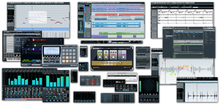- Music sequencer
-
Contents
The music sequencer (or simply sequencer) is a device or computer software to record, edit, play back the music, by handling note and performance information in several forms, typically : [note 1][note 2]
-
- MIDI data (on MIDI sequencers)
- CV/Gate data (on analog sequencers and others)
And also possibly includes :
-
- Automation data for various Plug-ins and DAWs
-
-
-
- (software instrument/effect Plug-ins and DAW features on software sequencers)
-
-
-
- Audio data (on audio sequencers including loop-based software)
- Automation data for various Plug-ins and DAWs
Note that normally bare music sequencer doesn't directly handle audio; instead, musical instruments/effects devices controlled by sequencers, or audio engines/DAWs integrated with software sequencers, are used to handle audio. Also note that computer software (or dedicated systems) mainly handle digital audio are traditionally called “Digital audio workstation” (DAW).
On the other aspect, music sequencers are categorized with its sequence mode/record mode:- Realtime mode: On the realtime sequencer, musical notes are recorded in realtime as on audio recorder, and played back with designated pitch, tempo and quantization. Often "punch in/punch out" features are also supported for realtime editing, however, to edit details, another editing mode may be needed. Built-in sequencers on electronic keyboards often support realtime mode.
- Step mode: On the step sequencer, musical notes are divided into steps, and each steps are recorded without exact timing. Instead, timing of each step are separately designated by order of entering steps (on bass machines), or column buttons (on drum machines). Analog drum machines and bass machines often utilize this mode, along with semi-realtime mode.
- Analog sequencers are sometimes confused with step sequencers, however, concepts of realtimeness and tempo are significantly different. Typical analog sequencers were designed for realtime composition and performance using multiple knobs/sliders, so, notes on sequence are always changeable without entering record mode. In addition, time between each notes (steps) are also independently adjustable.
- Software sequencers, in general, tend to support various sequence modes. Modern software sequencers with DAW features often support: piano rolls, strip charts, score edit, numerical edit, and also audio sequencing including re-arrangement of sample loops, beat slicing and pitch manipulation. Several sequencers are specialized to particular sequence mode: for example, loop-based music software specialized on audio sequence, software drum machines specialized on step sequence, etc.
Modern sequencers
Today's typical software sequencer, supporting multitrack audio and plug-ins (Steinberg Cubase 6[1])With the advent of MIDI and particularly Atari ST in 1980s, programmers were able to write software that could record and play back the notes played by a musician. Unlike the early sequencers used to play mechanical sounding sequence with exactly equal length, the new ones recorded and played back expressive performances by real musicians. These were typically used to control external synthesizers, especially rackmounted sound modules as it was no longer necessary for each synthesizer to have its own keyboard.
As the technology matured, sequencers gained more features, and integrated the ability to record multitrack audio. Sequencers used primarily for audio are often called digital audio workstations (or DAWs).
Many modern sequencers can also control virtual instruments implemented as software plug-ins, allowing musicians to replace separate synthesizers with software equivalents.
In today, the term "sequencer" is primarily used for software, however, also hardwares sequencers are remained. Workstation keyboards have their own proprietary built-in MIDI sequencers. Drum machines and some older synthesizers have their own step sequencer built in. There are still also standalone hardware MIDI sequencers, although the market demand for those has diminished greatly due to the greater feature set of their software counterparts.
Software sequencers / DAWs with sequencing features
Free/Open Source
-
- DAW with MIDI sequencers
- Frinika - Java (cross-platform)
- LMMS - GNU/Linux, Windows
- MusE - Linux
- Qtractor - Linux
- Rosegarden - Linux
- MIDI sequencers
- BRELS Midi Editor - Windows
- Edge - online MIDI Sequencer, (requires a web browser and Quicktime Player plugin installed)
- PianoRollComposer - Windows
- Sekaiju - Windows
- Loop-based MIDI sequencers
- harmonySEQ - Linux
- Seq24 - Linux, Windows
-
- Loop-based audio sequencers
- ThunderBeatD3 - Windows XP Vista 7(freeware)
- Integrated software studio environments
- The Buzz Machines - Windows
- Drum machines
- Hydrogen (cross platform, drum machine) - Linux, Mac OS X (Windows version discontinued)
- Scorewriters
- MuseScore - Linux, Windows, Mac
- Not categorized yet
-
- DAWs/HD recorders
- Ardour - Linux, Mac OS X, FreeBSD (Note: No sequence feature found)
- Others
Commercial
-
- DAWs with MIDI sequencers
- Audio Evolution from eXtream Software Development
- Cubase and Nuendo from Steinberg
- Digital Performer from MOTU
- energyXT from XT software
- FL Studio from Image Line Software
- Logic Pro and Logic Express from Apple
- Metro from Sagan Technology
- Mixcraft from Acoustica
- Orion Platinum from Synapse Audio
- Pro Tools from Avid
- Samplitude, Sequoia, Music Maker and Music Studio from Magix
- SAWStudio with Midi Workshop from RML Labs
- Sonar and Home Studio from Cakewalk
- Studio One from PreSonus
- Turbo Play (in test stage)
- Usine from Sensomusic
- Podium from Zynewave (gratis)
- Z-Maestro from Z-Systems
- Loop-based DAWs with MIDI sequencers
- ACID Pro and Cinescore from Sony Creative Software
- Live from Ableton
- GarageBand from Apple
- MU.LAB UL / XT / FREE - Windows Mac OS (gratis)
- REAPER from Cockos
- Tracktion from Mackie
- Tracker-based DAWs with MIDI sequencers
- MIDI sequencers
- Bars and Pipes Professional - Amiga (classic) (gratis)
- Master Tracks Pro from GVOX
-
- Integrated software studio environments
- Reason and Record from Propellerhead
- Project5 from Cakewalk
- Storm from Arturia
- Loop-based audio sequencers
- Live Touch XJ, from Ematrade - Android 3.0 Honeycomb tablet
- Loopseque from Casual Underground Lab - iPad/iPhone
- Realtime arrangers with MIDI sequencers
- Piano training software
- PianoCheater - Windows (gratis) (Guitar Hero style)
- Scorewriters
- Musette - Windows (gratis)
- Not categorized yet
-
- Realtime orchestral accompaniments
- Sinfonia , from Realtime Music Solutions (Note: It seems not the sequencer)
- Hard Disk recorder solutions for MIDI sequencers
- WinAudio from Zadok Audio & Media Products
- Others
Early sequencers and trackers
Earlier sequencers
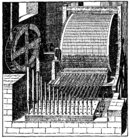
Large stationary barrel-organ (1615)
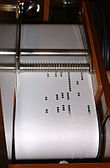
Player piano (1920) controlled by piano rolls

RCA Mark II (1957),
controlled via punch tapeThe earlier music sequencers had appeared in the form of various automatic musical instruments, including music boxes, mechanical organs, and player pianos. For example, several piano rolls were recorded by composers themselves, sometimes edited by specialists as the preparation before mass duplication, and finally played on consumer's player piano. And this process resembles the definition of musical sequencer.
The origin of automatic musical instruments seems considerably old. As early as 9th century, Persian inventors Banū Mūsā brothers invented hydropowered organ using exchangeable cylinders with pins,[2] and also automatic flute player using steam power,[3][4] as described on their Book of Ingenious Devices. In 14th century, rotating cylinder with pins were used to play carillon in Flanders,[citation needed] and at least in 15th century, barrel organs were seen in the Netherlands.[5] In 19th century, as the result of the Industrial Revolution, various automatic musical instruments were invented, includes music box, barrel organ and barrel piano using barrel / cylinder / metal disc with pins, or mechanical organ, orchestrion and player piano using book music / music rolls (piano rolls) with punched holes, etc. These instruments widely spread as the popular entertainment devices, before the invention of phonograph and radio.
Also in 20th century, earliest programmable music synthesizers , RCA Mark II Sound Synthesizer in 1957 and Siemens Synthesizer in 1959 were also controlled via punch tapes similar to piano rolls. [6][7]
On the other hand, American composer Raymond Scott invented various music sequencers for his electric compositions. Wall of Sound, once covered on the wall of his studio in 1940s, was a electro-mechanical sequencer to produce rhythmic patterns, consisted with stepping relays used on dial pulse telephone exchange, solenoids, control switches, and tone circuits with 16 individual oscillators. [8] Later, Robert Moog explained it “the whole room would go 'clack - clack - clack', and the sounds would come out all over the place”.[9] Circle Machine, developed in 1959, had dimmer bulbs arranged in a ring, and a rotating arm with photocell scanning over ring, to generate arbitrary waveform. Circle Machine, developed in 1959, had a ring with dimmer bulbs around them, and photocell on the rotating arm over it, to generate arbitrary waveform. [10] And relatively well known Clavivox, developed since 1952, was a kind of keyboard synthesizer with sequencer. On its prototype, theremin manufactured by young Robert Moog was utilized to enable portamento over 3-octave range, and on later version, instead photographic film was utilized to control pitch by voltage. [9]
With the relation to the photographic films, also drawn sound technique, appeared in late 1920s, may be important as a precursor of today's intuitive graphical user interfaces. On this technique, notes and various sound parameters were controlled by hand-drawn waves on the films, these resemble piano rolls or strip charts on the modern sequencers/DAWs. This technique was often utilized on early experiments of electronic music, including "Variophone" developed by Yevgeny Sholpo in 1930, and Oramics designed by Daphne Oram in 1957, etc.
Analog sequencers
Step sequencers
The step sequencers played rigid patterns of notes using a grid of (usually) 16 buttons, or steps, each step being 1/16 of a measure. These patterns of notes were then chained together to form longer compositions. Sequencers of this kind are still in use, mostly built into drum machines and grooveboxes. They are monophonic by nature, although some are multi-timbral, meaning that they can control several different sounds but only play one note on each of those sounds.[clarification needed]
Computer music

CSIRAC played earliest computer music in 1951
Max Mathews playing a violin connected to the GROOVE system(c.1970)
On the other hand, software sequencers were continuously utilized since 1950s, in the context of computer music including computer played music (software sequencer), computer composed music (music synthesis), and computer sound generation (sound synthesis). In June 1951, first computer music Colonel Bogey was played on CSIRAC, Australia's first digital computer.[14][15] In 1956, Lejaren Hiller at University of Illinois at Urbana-Champaign wrote an earliest program for computer music composition on ILLIAC, and collaborated on the first piece, Illiac Suite for String Quartet, with Leonard Issaction.[16] In 1957, Max Mathews at Bell Labs wrote MUSIC, a first widely-used program for sound generation, and 17 second composition was performed by the IBM 704 computer. Since then, computer music were mainly researched on the expensive mainframe computers at the computer centers, until minicomputers and later microcomputers went into practice on this field in 1970s.
Digital sequencers

EMS Sequencer 256 (1971), branched product from Synthi 100

Roland MC-4 (1981), a successor of MC-8 (1977)
In 1971, Electronic Music Studios (EMS) released one of the first digital sequencer products as a module of Synthi 100, and separated products Synthi Sequencer series.[17][18] After then, Oberheim released DS-2 Digital Sequencer in 1974,[19], and Sequential Circuits released Model 800 in 1977 [20]
Also in 1977, Roland Corporation released their first microcomputer-based digital sequencer, MC-8 Microcomposer, also called computer music composer by Roland. [21] It equipped keypad to enter note in numeric code, 16KB RAM for maximum 5200 notes (large enough at that time), and polyphony function which allocates multiple pitch CV into single Gate. [22] The earliest known user was Yellow Magic Orchestra, an electronic music group in 1978, [23] they created new sounds not possible until then.[peacock term][24][not in citation given]
Software sequencers
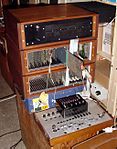
Synclavier I (1977)
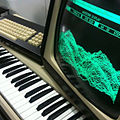
Fairlight CMI (1979), a successor of Quasar (1975-1977)
In 1975, New England Digital (NED) released ABLE computer (microcomputer)[25] as a dedicated data processing unit for Dartmouth Digital Synthesizer (1973), and based on it, later Synclavier series were developed. Synclavier I, released in September 1977, was one of the earlier digital music workstation product with multitrack sequencer. [26] Synclavier series evolved throughout late 1970s–mid 1980s, and they integrated digital-audio and music-sequencer, on the Direct-to-Disk option in 1984, and later Tapeless Studio system.
In 1980, renewed Fairlight CMI Series II with its sequencer, “Page R”, combined step sequencing with sample playback. In 1987, this led to the development of similar software sequencers of this kind, called Trackers, which became popular in the 1980s and 1990s as simple sequencers for creating computer game music, and are yet popular in the Demoscene and Chiptunes.
- Short timeline of rhythm sequencers

mechanical (pre 20c)


Rhythmicon (1930)


Drum machine
(late 1950s–)


Step drum machine (1972–)


Digital drum machine (1980–)

“Page R” on Fairlight (c.1980)


Groove machine (mid 1980s–)

Tracker (1987–)


Beat slicer (1990s–)

Loop sequencer (1998–)


Note manipulation on audio tracks (2009–)
Hardware sequencers
Many synthesizers, and by definition all workstations and drum machines, contain their own sequencers.
Following are specifically designed to function primarily as sequencers:
Rotating object with pins
-
- Barrel or cylinder with pins (9th or 14th century) utilized on barrel organs, carillons, music boxes
- Disc with pins — utilized on several barrel organs
Punched paper
-
- Book music (1890–) utilized on several mechanical organs
- Music roll utilized on player pianos (using piano rolls), Orchestrions, several mechanical organs, etc.
- Punch tape system for early synthesizers
- RCA Mark II Sound Synthesizer (1957)
- Room-filling device built in 1957 for half a million dollars. Included a 4-polyphony synth with 12 oscillators, a sequencer fed with wide paper tape, and output were recorded on a shellac record lathe.
- Siemens Synthesizer (1959)
- RCA Mark II Sound Synthesizer (1957)
Sound-on-film
-
- Variophone (1930) — On earlier version, film or disc with hand drawn waves were used for synthesizing sound, and later versions were promised to experiment on musical intonations and temporal characteristics of live music performance, however not finished. Variophone is often referred as a forerunner of drawn sound system including ANS synthesizer and Oramics.
- Composer-Tron (1953) — rhythmical sequences were controlled via marking cue on film, while timbre of note or envelope shape of sound were defined via shapes hand drawn on a CRT input device's surface with a grease pencil.[27]
- ANS synthesizer (1957) — 720 microtonal sine waves (1/6 semitones × 10octave) were generated by five rotating glass discs, then these microtones were sequenced for sound synthesizing, via user interface scratched on glass plate covered with black mastic.
- Oramics (1957) — hand drawn contours on a set of ten sprocketed synchronized strips of 35 film were used to control various parameters of monophonic sound generator (frequency, timbre, amplitude and duration).[28] Polyphonic sounds were obtained using multitrack recording technique.
Electro-mechanical sequencers
-
- Wall of Sound (mid 1940s–1950s)
- Circle Machine (1959)
- Clavivox (1952–late 1950s)
Analog sequencers
-
- Analog sequencers with CV/Gate interface
- Moog 960 Sequential Controller
- a module for the Moog modular synthesizer system, one of the earliest analog sequencer in the modular-synthesizer era.
-
- Serge Modular TKB
- Synthesizers.com Q119
- Synthesizers.com Q960 — reissue of Moog 960
-
- Analog-style MIDI step sequencers
- Since the analog synthesizer revivals in 1990s, newly designed MIDI sequencers were released. These equip multiple knobs or sliders similar to analog sequencer, CV/Gate and DIN sync interface, and even patch memory for sequence patterns. These analog-digital hybrid machines are often called analog-type MIDI step sequencer or MIDI analog sequencer, etc.
-
- MIDI pattern sequencers
- Several machines have also song mode to play sequence patterns on patch memory in specified order, as on drum machine.
- Doepfer Schaltwerk —MIDI pattern sequencer
Step sequencers (supported on)
- Typical step sequencers are integrated on drum machines, bass machines, groove machines, and these software versions. And these sequencers often support (semi-)realtime record mode along with step sequence mode.
- Several machines have white & black chromatic keypads, for convenience to enter musical scale of bass line etc.
- embedded CV/Gate step sequencers
- Multivox / Firstman SQ-01 — a forerunner of TB-303
- Roland MC-202
- Roland SH-101 — monophonic keytar synthesizer with sequencer, similar to MC-202
- Roland TB-303
-
- embedded MIDI step sequencers
-
- Korg Electribe series
- Roland MC-09
- Roland MC-303
- Roland MC-505
- Other groovebox-type machines also often support step sequence mode. (though input methods of musical scale may vary):
-
- E-mu SP-12
- E-mu SP-1200
- Linn 9000
- Akai MPC series
- Native Instruments Maschine (software)
-
- Roland MV-30
- Roland MV-8000 — sampling workstation
- Sequential Circuits Studio 440
- Yamaha RS7000 — sampling workstation
- Recently emerging button-grid-style interfaces/instruments are naturally support step sequence. On these machines, one axis on grid means musical scale, and another axis means timing of notes.
- In addition, newly designed hardware MIDI sequencers equipping multiple knobs/sliders like an analog sequencers, are sometimes called "MIDI step sequencer", etc. For details, see #Analog-style MIDI step sequencers.
Digital sequencers
-
- EDP Spider (late 1970s) — supported LINK and CV/Gate
- EMS Sequencer series (1971)
- Max Mathews GROOVE system (1970)
- MX-8100 / Firstman SQ-10 (1979/1980) — supported V/Oct. and Hz/V
- Oberheim Electronics DS-2 (1974)
-
- Roland CSQ-100
- Roland CSQ-600 (1980) — 600 notes for individual 4 tracks,[29] a buddy of TR-808
- Roland MC-4 Microcomposer (1981)
- Roland MC-8 Microcomposer (1977) — also supported DCB via OP-8
- Sequential Circuits Model 800 (1977)
-
- Proprietary digital interface (pre MIDI)
- NED Synclavier series — CV/Gate interface and MIDI retrofit were available on Synclavier II. Also MIDI became standard feature on Synclavier PSMT. [30][31]
- Fairlight CMI series — CV/Gate interface was optionally available on Series II, and MIDI was supported on Series IIx and later models.
- Oberheim DSX (Oberheim Parallel Bus)
- PPG Wave family (PPG Bus)
- Roland JSQ-60 (Roland Digital Control Bus (DCB))
- Sequential Circuits PolySequencer (SCI Serial Bus)
- Also Yamaha used proprietary digital interface on their earlier digital products. YIS PU-I-20/PU-I-10 in 1980, a home automation computer system before MSX, enabled integration of home electronics including player piano, Electone, and remote music keyboard.[32][33]
MIDI sequencers
-
- Embedded MIDI sequencers
- Philips Micro Composer PMC100
- Yamaha Walkstation series: MU5/MU10/MU15/QY8/QY10/QY20/QY22/QY70/QY100 — (palmtop sequencer with sound module)
- Accompaniment machines
- Yamaha QR10
- See also #embedded MIDI step sequencers.
-
- Standalone MIDI sequencers
-
- Akai ASQ10
- Alesis MMT-8
- Korg SQ-8 — palmtop
- Korg SQD-1
- Korg SQD-8
- Kawai Q-80
- Roland MC-327[citation needed]
-
- Roland MC series: MC-50/MC-50MkII/MC-80/MC-300/MC-500 Microcomposer
- MSQ-100 (1985)
- MSQ-700 (1984) — one of the earliest multitrack MIDI sequencer (8tr),[34] a buddy of TR-909
- Roland PMA-5 — palmtop with touch screen
- Roland SB-55 — SMF recorder
- Yamaha QX series: QX1/QX3/QX5/QX7/QX21
- Yamaha QY300 — with embedded sound module
- Yamaha QY700 — with embedded sound module
- See also: #Analog-style MIDI step sequencers
-
- MIDI phrase sequencers
- Zyklus MPS
Uncategorized sequencers
- (not yet)
See also
- Drum machine
- Groovebox
- Music workstation
- Digital audio workstation
- Tracker (music software)
- Scorewriter
Notes
- ^ Modern music sequencers integrated with DAWs are often supporting MIDI, digital audio, and plug-ins. However, it is not the definition of musical sequencer. Digital audio handled by DAW features, and plug-ins handled by plug-in hosts, may be out of concerns for bare musical sequencers (except for audio sequencer).
- ^ Similarly, although modern music sequencers often mainly support MIDI and plug-ins, it is not the definition of music sequencer. On the history of electronic music, various music sequencers handled various form of information, as following:
- Analog sequencers handle analog data (ex. CV/Gate)
- Several digital devices/software handle proprietary data on sequencer (workstations and sequencers developed before MIDI era, self-contained integrated environments, or relatively simple devices without MIDI/USB IF).
- Plug-in's numerous parameters or automation data on DAWs are often handled without MIDI mapping; in this case, these data are clearly non MIDI data.
- Also modern integrated DAW sometimes handles notes on audio track in the analogy of MIDI notes, with the help of “beat slicing” (ex. ReCycle!), “independent control of pitch/time” (ex. loop-based audio sequencers such as Acid, REAPER, GarageBand)), and “source separation” technology (ex. Melodyne Direct Note Access (DNA)), without MIDI mapping.
- More over, piano rolls and drawn sound technique in the last century are still used on modern sequencers/DAWs as graphical user interfaces.
References
- ^ "Cubase 6 screenshot licensed under CC-BY-SA-3.0". Steinberg Media Technologies GmbH. http://www.steinberg.net/en/landing_pages/c6_creative_commons.
- ^ Fowler, Charles B. (October 1967). "The Museum of Music: A History of Mechanical Instruments". Music Educators Journal (Music Educators Journal) 54 (2): 45–49. doi:10.2307/3391092. JSTOR 3391092.
- ^ Koetsier, Teun (2001). "On the prehistory of programmable machines: musical automata, looms, calculators". Mechanism and Machine Theory (Elsevier) 36 (5): 589–603. doi:10.1016/S0094-114X(01)00005-2.
- ^ Banu Musa (authors) (1979). Donald Routledge Hill (translator). ed. The book of ingenious devices (Kitāb al-ḥiyal). Springer. pp. 76–7. ISBN 9027708339.
- ^ [w:wikisource:1911_Encyclopædia_Britannica/Barrel-organ "Barrel-organ"]. Encyclopædia Britannica. 1911. w:wikisource:1911_Encyclopædia_Britannica/Barrel-organ.
- ^ "The RCA Synthesiser". 120 Years of Electronic Music. http://120years.net/machines/rca/. — (PDF version is available])
- ^ "Das Siemens-Studio für elektronische Musik von Alexander Schaaf und Helmut Klein" (in Deutsch). Deutsches Museum. http://www.deutsches-museum.de/sammlungen/ausgewaehlte-objekte/meisterwerke-vi/siemens-studio/.
- ^ "Wall of Sound (sequencer)". RaymondScott.com. http://raymondscott.com/1946.htm.
- ^ a b Robert Moog. "Memories of Raymond Scott". RaymondScott.com. http://raymondscott.com/moog.html.
- ^ "Circle Machine". RaymondScott.com. http://raymondscott.com/circle.html. — includes 2 sound files: Raymond Scott's demonstration, and commercial soundtrack for new batteries of Ford Motors.
- ^ "EKO Computerhythm (1972)". Jarrography - The ultimate Jean Michel Jarre discography. http://www.jarrography.free.fr/details_equipement_audio.php?id_equip=117.
- ^ "EKO Computerhythm". SynthMaster.de. http://www.synthmaster.de/ekodrum.htm.
- ^ "Multivox International" (in Germany). SYNRISE. Archived from the original on 2003-04-20. http://web.archive.org/web/20030420170643/http://www.synrise.de/docs/types/f/firstman.htm.
- ^ "CSIRAC: Australia's first computer". http://www.csiro.au/science/ps4f.html. Retrieved 2007-12-21.
- ^ Fildes, Jonathan (2008-06-17). "'Oldest' computer music unveiled". BBC News Online. http://news.bbc.co.uk/1/hi/technology/7458479.stm. Retrieved 2008-06-18. — another oldest known recording of computer realized music played by the Ferranti Mark 1, captured by BBC in Autumn, 1951; the songs Baa Baa Black Sheep and In the Mood.
- ^ Hiller, Lejaren (Winter 1981). "Composing with Computer: A Progress Report". Computer Music Journal 5 (Winter 1981).
also available in Curtis Roads, ed. The Music Machine: Selected Readings from Computer Music Journal. MIT Press (1989/1992). pp. 75. ISBN 9780262680783. - ^ Hinton, Graham (2001). "Synthi 100 (1971, formerly Digitana, aka the Delaware)". Electronic Music Studios (Cornwall). http://www.ems-synthi.demon.co.uk/emsprods.html#synthi100.
- ^ Hinton, Graham (2001). "Synthi Sequencer 256 (1971, formerly Synthi Moog Sequencer)". Electronic Music Studios (Cornwall). http://www.ems-synthi.demon.co.uk/emsprods.html#seq256.
- ^ J.Michmerhuizen (Boston School of Electronic Music); Thomas E. Oberheim (Oberheim Electronics) (June 1974). DS-2 Digital Sequencer Instruction and Service Manual. http://www.cem3374.com/docs/Manuals/Oberheim/DS2_O&SM.pdf.
- ^ "Model 800 Sequencer". SynthMuseum.com. http://www.synthmuseum.com/sequ/seqseq80001.html.
- ^ Russ, Martin (2008). Sound Synthesis and Sampling. Focal Press. p. 346. ISBN 0240521056. http://books.google.co.uk/books?id=_D2cTt5DPmEC&pg=PA346. Retrieved 21 June 2011.
- ^ Gordon Reid (Nov. 2004). "The History Of Roland Part 1: 1930-1978". Sound On Sound. http://www.soundonsound.com/sos/nov04/articles/roland.htm. Retrieved 2011-06-19.
- ^ Yellow Magic Orchestra — Yellow Magic Orchestra at Discogs
- ^ "Artists and producers strive for inroads overseas". Billboard 91 (20): 61. 26 May 1979. ISSN 0006-2510. http://books.google.co.uk/books?id=_iQEAAAAMBAJ&pg=PT61. Retrieved 2011-05-29.
- ^ "Synclavier Early History". Synclavier European Services. http://www.500sound.com/synclavierhistory.html.
- ^ Joel Chadabe (May 1, 2001). "The Electronic Century Part IV: The Seeds of the Future". Electronic Musician. http://emusician.com/tutorials/electronic_century4/. "In September 1977, I bought the first Synclavier, although mine came without the special keyboard and control panel ... (see Fig. 1 on the page)."
- ^ "The Composer-Tron (1953)". 120years.net. http://120years.net/machines/composertron/.
- ^ "Daphne Oram and 'Oramics' (1959)". 120 Years of Electronic Music. http://120years.net/machines/oramics/index.html.
- ^ "SM0600 Project - A Digital Sequencer - Rebuilding the Roland CSQ-700". Emulator Archive. http://www.emulatorarchive.com/AM/AMProjects/CSQ600/csq600.html.
- ^ Brandon Amison (17 Jul. 1999). "Yaking Cat Music Studios QAQA answers - Subject:0033 Re:Clothing ETC.". Yaking Cat Music Studios (Synclavier Assistance). http://home.earthlink.net/~yaking/html/answers/0033.html.
- ^ Furia, Steve De (1986). The MIDI implementation book. Third Earth Pub. p. 25. ISBN 9780881885583. — MIDI Implementation Chart of Synclavier MIDI Option v0.9 in 1985.
- ^ "Survey report on trends in electronic documents" (in Japanese). Japan Electronics and Information Technology Industries Association (JEITA). Archived from the original on June 2003. http://n-bz.sakura.ne.jp/around-the-music/essays/dtm-1sub.htm.
- ^ |title = Cool machines - Yamaha YIS PU-I-20 |url = http://www.geocities.jp/ahirudanna/zatsubun06.html |language = Japanese }} —
- ^ "AM MSQ700 Nexus - MIDI Sequencer". Emulator Archive. http://www.emulatorarchive.com/AM/AMProjects/MSQ700/msq700.html.
External links
Categories:- Music sequencers
- Sound production technology
- MIDI
- Music software
- Synthesiser modules
-
Wikimedia Foundation. 2010.











